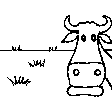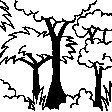



The land of the farmer is of 3 acres: 2 acres to plant maize (Zea mays) intercropped with beans (Phaseolus vulgaris) in combination with several trees species: Mangoes, Avocadoes, Bananas, Grevillea and Makadamia and half acre for coffee plantation with Bananas and half with Napier grass production for fodder (to feed cows). To increase and fasten the grass growth, manure is applied twice a year, before the rainy season (around February and September), while mulching is practiced under Banana trees every season. Minimum tillage is applied to reduce soil disturbance and to increase water use efficiency by minimizing direct evaporation, increasing infiltration and water recharge (Liniger, 1991) especially during dry seasons, which results in better crop yields.
For timber production Grevillea trees are planted scattered overall the land and on the edge of the river for demarcation (environmental role in stabilizing the soil against erosive forces).
Concerning the structural measures, the farmer constructed has built 14 bench terraces, six of them were designed to plant cash crops (coffee); each terrace is characterized by a ditch to cut off the drainage and collect water and nutrients; they are also used as paths to facilitate transportation and farm operations. Ditches are both drainage and infiltration types and are excavated along the contour.
Purpose of the Technology: Beans and maize are cultivated for home consumption but partially (about 20%-4 bags of maize and half bag of beans) also for commercial purposes. Coffee is harvested twice a year, with a production of about 500 kg per season; the coffee is sold at 45 Kenyan Shillings (KSh) per kg (SL-28-arabica varieties). Indeed, the farmer is interested in cultivating the certified and improved variety called Ruiru 11 which is generally disease resistant, easy to maintain (less expensive) with a modest risk of pests (according to the farmer). Grevillea timber is sold twice a year, only trees of 1.5 feet in diameter (about 45 cm), at about 80 KSh per feet. Beside the commercial role of Grevillea, when sufficiently grown these trees lead to a reduction of the wind speed, protect the intercrops and provide mulching material to be used over banana trees. The deep roots of mature Grevillea are not in competition with the crops for soil and water, instead they enhance infiltration (Otengi, 2007). Makadamia will be used to produce cooking oil, while bananas, avocados and mangoes are fruits collected for the local markets. Napier grass is cultivated to stabilize the ditches and for fodder production.
Establishment / maintenance activities and inputs: There is a high initial input (mainly labour) needed to create ditches and terraces and for planting crops is required. The vegetative and structural measures require a labour intensive management during the year, for example maintenance is necessary after each rainy season to repair ditches and to rebuild terraces (e.g. because of the accumulation of soil and organic matter in the pits and ditches). Concerning Napier grass, labour is employed regularly for weed control, to cut grass for fodder and every three seasons to replace and replant the grass because it becomes less productive. Concerning trees, in the Agroforestry systems, canopies of Mango and Avocado trees shade the soil reducing evapotranspiration and therefore improving soil water storage. On the other hand, regular pruning is needed when the shadow effect obstructs photosynthesis and therefore growth of the crops planted below (maize and beans). Pruning of branches is carried out also for firewood. Furthermore, a common practice is Grevillea root pruning to conserve soil moisture (Otengi, 2007) and to reduce competition for nutrients during the growing season. Indeed, the farmer explained how superficial roots may interfere with the Banana root system and to cut them he has created small trenches. Harvesting is carried out twice during the year for both cereals and coffee.
Natural / human environment: The area is characterized by rolling to hilly slopes, therefore it is exposed to erosion and land degradation. The combination of trees with mixed crops is adopted to maximise productivity and at the same time to prevent degradation by increasing the vegetative cover.

Localização: Muthithi location-Kagurumo sublocation-Gatwamikwa village, Kenya, Quênia
Nº de sites de tecnologia analisados:
Difusão da tecnologia: Uniformemente difundida numa área (0.0121 km²)
Em uma área permanentemente protegida?:
Data da implementação: mais de 50 anos atrás (tradicional)
Tipo de introdução











| Especifique a entrada | Unidade | Quantidade | Custos por unidade (Kenyan Schellings) | Custos totais por entrada (Kenyan Schellings) | % dos custos arcados pelos usuários da terra |
| Mão-de-obra | |||||
| Digging holes and planting seedlings | person/day | 20,0 | 2,3 | 46,0 | 100,0 |
| Infiltration ditches | person/day | 1,0 | 1277,0 | 1277,0 | 100,0 |
| Establishment of the infiltration ditches and cutoff drains (total 5) | person/day | 15,0 | 2,333 | 35,0 | 100,0 |
| stablishment of the retention ditches with bench terraces (tot.8) | person/day | 16,0 | 2,9375 | 47,0 | 100,0 |
| Equipamento | |||||
| Cow | pieces | 2,0 | 349,0 | 698,0 | |
| Material vegetal | |||||
| Seedlings Mango | pieces | 10,0 | 0,2 | 2,0 | 100,0 |
| Coffee seedlings | pieces | 250,0 | 0,464 | 116,0 | 100,0 |
| Seedlings Avocado | pieces | 12,0 | 0,25 | 3,0 | 100,0 |
| Seedlings Macadamia | pieces | 8,0 | 0,25 | 2,0 | 100,0 |
| Grevillea | pieces | 50,0 | 0,12 | 6,0 | 100,0 |
| Outros | |||||
| cows | animal | 2,0 | 349,0 | 698,0 | 100,0 |
| Custos totais para a implantação da tecnologia | 2'930.0 | ||||
| Custos totais para o estabelecimento da Tecnologia em USD | 34.11 | ||||
| Especifique a entrada | Unidade | Quantidade | Custos por unidade (Kenyan Schellings) | Custos totais por entrada (Kenyan Schellings) | % dos custos arcados pelos usuários da terra |
| Mão-de-obra | |||||
| Minimum tillage and planting maize and beans | person/days | 15,0 | 1,5333 | 23,0 | 100,0 |
| Harvesting maize/beans | person/days | 10,0 | 1,2 | 12,0 | 100,0 |
| Feeding cows and preparing the manure on daily basis | person/days | 312,0 | 0,166666 | 52,0 | 100,0 |
| Preparation and application of manure | person/days | 2,0 | 2,5 | 5,0 | 100,0 |
| Material vegetal | |||||
| Seeds Maize | kg | 10,0 | 2,3 | 23,0 | 100,0 |
| Seeds Beans | kg | 5,0 | 2,0 | 10,0 | 100,0 |
| Seedlings grass | per trench | 200,0 | |||
| Outros | |||||
| Labour: Digging planting holes and planting grass | person/days | 5,0 | 1,8 | 9,0 | 100,0 |
| Labour: Maintenance of the grass (weed control and cutting Napier grass/repairing and collecting fodder) | person/days | 3,0 | 1,66666 | 5,0 | 100,0 |
| Labour: Clearing the tree for selling timber (the price depends also of the use of the chainsaw (or saw) or not -(considering 4 trees at the time) - with machine operator | person/days | 1,0 | 8,0 | 8,0 | 100,0 |
| Labour: Repairing the ditches and remove excess of soil/leaves accumulated during the rainy season | person/days | 2,0 | 2,5 | 5,0 | 100,0 |
| Labour: Rebuilt repair terraces | person/days | 5,0 | 1,8 | 9,0 | 100,0 |
| Custos totais para a manutenção da tecnologia | 161.0 | ||||
| Custos totais de manutenção da Tecnologia em USD | 1.87 | ||||